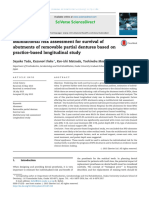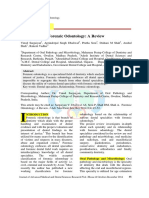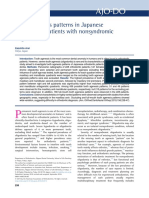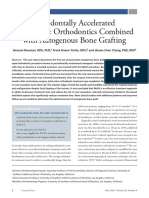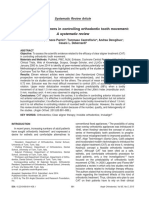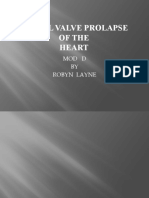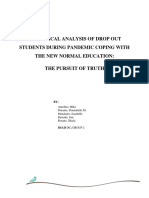Angle Orthod 2013 83 36-42
Angle Orthod 2013 83 36-42
Uploaded by
brookortontiaCopyright:
Available Formats
Angle Orthod 2013 83 36-42
Angle Orthod 2013 83 36-42
Uploaded by
brookortontiaOriginal Description:
Original Title
Copyright
Available Formats
Share this document
Did you find this document useful?
Is this content inappropriate?
Copyright:
Available Formats
Angle Orthod 2013 83 36-42
Angle Orthod 2013 83 36-42
Uploaded by
brookortontiaCopyright:
Available Formats
Original Article
Relationships between the root-crown ratio and the loss of occlusal contact
and high mandibular plane angle in patients with open bite
Sawako Ueharaa; Aya Maedab; Hiroshi Tomonarib; Shouichi Miyawakic
ABSTRACT
Objective: To determine the root-crown (R/C) ratio and dental root length of teeth in patients with
Downloaded from http://meridian.allenpress.com/angle-orthodontist/article-pdf/83/1/36/1413723/042412-341_1.pdf by guest on 07 August 2020
open bite and seek any relationships with occlusal contact (OC) and the mandibular plane (Mp)
angle.
Materials and Methods: Thirty-one patients with open bite with negative overbite of at least four
anterior teeth and 31 control patients with clinically normal overjet and overbite were enrolled. R/C
ratios, dental root length, OC, and Mp angle were measured using panoramic radiographs, dental
casts, and cephalograms, respectively. Mean differences between the groups, and variations
between the R/C ratio or root length and Mp angle in patients with open bite were statistically
analyzed.
Results: R/C and OC ratios from the incisors to premolars were significantly lower for patients with
open bite than for controls, and some teeth had short dental roots. Relationships between low R/C
ratio or root length and high Mp angle were significant in patients with open bite.
Conclusion: Patients with open bite, especially those with a high Mp angle, have an unfavorable
R/C ratio and short dental roots in some teeth, which may be related to the loss of OC. (Angle
Orthod. 2013;83:36–42.)
KEY WORDS: Open bite; Root-crown ratio; Root length; Occlusal contact; High mandibular-plane
angle
INTRODUCTION This suggests that loss of occlusal contact (OC), as in
open-bite malocclusion, may increase the loss of teeth.
According to a recent epidemiologic study, elderly
Studies of root morphology have shown that patients
people with many teeth have relatively good occlusion;
with open bite are at risk for root resorption during
their incidence of open-bite malocclusion is very low.1
orthodontic treatment.2,3 The dental roots of maxillary
central incisors in patients with open bite have been
a
Postgraduate Student, Department of Orthodontics, Field of reported to be short.4 Moreover, the loss of normal
Developmental Medicine, Health Research Course, Graduate occlusal function or OC, that is, occlusal hypofunction
School of Medical and Dental Sciences, Kagoshima University, due to tooth loss or in malocclusions such as open bite,
Kagoshima, Japan.
b
Assistant Professor, Department of Orthodontics, Field of
leads to root resorption during tooth movement.5 Thus,
Developmental Medicine, Health Research Course, Graduate open-bite malocclusion and loss of OC play an important
School of Medical and Dental Sciences, Kagoshima University, role in dental root morphology, although the details
Kagoshima, Japan. remain unclear. Additionally, open bite has various
c
Professor and Department Chair, Department of Orthodon- morphologic features, such as high mandibular plane
tics, Field of Developmental Medicine, Health Research Course,
(Mp) angle and long face.6 It has been reported that
Graduate School of Medical and Dental Sciences, Kagoshima
University, Kagoshima, Japan. patients with open bite and/or long face often exhibit a
Corresponding author: Dr Shouichi Miyawaki, Department weak occlusal force.6 In addition, low occlusal stimuli
of Orthodontics, Field of Developmental Medicine, Health may cause malocclusion and morphologic features such
Research Course, Graduate School of Medical and Dental as open bite and long face.7 However, the relationship
Sciences, Kagoshima University, 8-35-1 Sakuragaoka, Ka-
between the dental root length and the Mp angle is
goshima 890-8544, Japan
(e-mail: miyawaki@dent.kagoshima-u.ac.jp) unclear. In this study, we focused on the dental root
length, OC, and high Mp angle in patients with open bite.
Accepted: July 2012. Submitted: April 2012.
Published Online: August 16, 2012 An unfavorable root-crown (R/C) ratio due to short
G 2013 by The EH Angle Education and Research Foundation, dental roots may affect the prognosis of teeth.
Inc. Clinically, a short root may complicate treatment
Angle Orthodontist, Vol 83, No 1, 2013 36 DOI: 10.2319/042412-341.1
ROOT-CROWN RATIO IN PATIENTS WITH OPEN BITE 37
Table 1. Summary of Subject Dataa morphologies. The radiographs were traced by the
Control Open-Bite authors, and landmarks were identified and digitized
Group Group P Value with a protractor and digital caliper. Bilateral structures
Number 31 31 were bisected and their midsagittal points were
Age (y; mean 6 SD) 24.2 6 4.0 22.5 6 5.9 NSb identified. To assess intraexaminer reproducibility
Gender (female/total) 21/31 17/31 NSc and reliability of the measurements, 15 cephalometric
a
NS indicates not significant. radiographs were retraced at a minimum interval of
b
Unpaired t-test. 2 months. Differences between the original and
c
Fisher’s exact test.
retraced radiographs were statistically analyzed using
a matched paired t-test. The cephalometric analysis
planning in orthodontic management or prosthodontics, indicated no statistically significant differences be-
because short roots influence the anchorage and tween the original and repeat measurements.
Downloaded from http://meridian.allenpress.com/angle-orthodontist/article-pdf/83/1/36/1413723/042412-341_1.pdf by guest on 07 August 2020
mobility of teeth. Short dental roots have been observed Dental casts. Dental wear was assessed using the
in some disorders, including Down syndrome,8 Turner tooth wear index11 because individual teeth with
syndrome,9 and cleft lip and palate.10 Some studies substantial tooth wear were excluded in this study.
have reported that teeth with open-bite malocclusion Moreover, the percentage of patients with OC on each
are at high risk for root resorption during orthodontic tooth in the centric occlusion position was examined by
treatment.2,3 However, few studies have evaluated the dental cast. If contact was detected at least one point
original dental root length in patients with open bite.4 for each tooth, the patient was considered to have OC.
The purpose of this study was to examine the R/C ratio Panoramic radiographs. We used R/C ratios in
and dental root length of all teeth in patients with open dental panoramic radiographs showing the maxilla
bite and its relationships to OC and the Mp angle. and mandible to assess the dental root length using
the method of Lind.12–15 Outlines of the permanent
MATERIALS AND METHODS maxillary and mandibular teeth were traced on acetate
sheets from the panoramic radiographs, and the root
Subjects apex point, incisal edge point, and cement enamel
From 1998 to 2011, 1473 patients visited the junction point were additionally marked. In teeth with
Department of Orthodontics at Kagoshima University two roots, the root apex point was chosen as the
Medical and Dental Hospital, Kagoshima, Japan, and buccal root; in teeth with two buccal roots, the longer
were diagnosed using panoramic and cephalometric root was marked as the root apex point. In most
radiographs and dental casts. Among these 1473 incisors and molars, two points on the mesial and distal
consecutive patients, all patients who met the following incisal edges or buccal cusps were marked as the
exclusion and inclusion criteria were selected as open- incisal edge points. In canines and most premolars,
bite or control group subjects in the present study. one point was marked as the incisal edge point. The
Exclusion criteria for both groups were (1) ,15 years acetate sheets with the outlines of the teeth and critical
old, because the third molars and other permanent tooth points were scanned at 1000 dpi resolution and viewed
roots complete their growth around 14 years; (2) cleft lip on a large monitor, and each point on the scanned
and/or palate; (3) craniofacial syndromes; (4) loss of .1 images was retraced. For measuring the R/C ratio,
permanent tooth; or (5) history of orthodontic treatment. three parallel reference lines were drawn on the basis
Inclusion criterion for the open-bite group was a negative of points traced on the large monitor. Crown height
overbite of at least 4 anterior teeth, and inclusion criteria was measured along the perpendicular line from line i
for the control group were a 1–4 mm overbite and a to line m. Root length was measured along the
1–4 mm overjet. Ultimately, the open-bite group perpendicular line from line a to line m (Figure 1).
consisted of 31 patients with open bite, and the control The R/C ratio of an individual tooth was calculated by
group consisted of 31 patients with malocclusion. No dividing the root length by the crown height. The
significant differences were noted in the mean age or the criteria for excluding individual teeth were as follows:
(1) the reference points were not clearly visible, that is,
female to male ratio between the open-bite and control
there was major overlapping of teeth (n 5 23), diffuse
groups (Table 1). The study design was approved by the
images (n 5 9), outside the image layer (n 5 10), or
Kagoshima University Ethics Committee (#183).
overlapping of the cervical spine (n 5 4); (2) extensive
caries, restorations, or endodontic treatment (n 5
Measurements
114); or (3) a tooth wear index score .1 (n 5 50).
Cephalometrics. We used lateral cephalometric To support the low accuracy of the dental panoramic
radiographs, taken for orthodontic diagnosis for all radiographs, we evaluated the method error (ME) for
subjects, to reveal the characteristics of dentofacial use of dental panoramic radiographs compared with
Angle Orthodontist, Vol 83, No 1, 2013
38 UEHARA, MAEDA, TOMONARI, MIYAWAKI
Differences between the original and retraced radio-
graphs were statistically analyzed using a paired t-test.
The correlations for the repeated intraexaminer R/C
ratio and root length assessment analysis showed
no statistically significant differences. The mean ME
values for the R/C ratio and root length were 0.088
(range, 0.064–0.110) and 0.50 mm (range, 0.29–0.89),
respectively.
Statistical Analysis
Figure 1. Measurement of the root-crown (R/C) ratio in a tooth. Line
i, connecting the incisal edges or buccal cusps; line a, touching the Differences in all variables between the open-bite
Downloaded from http://meridian.allenpress.com/angle-orthodontist/article-pdf/83/1/36/1413723/042412-341_1.pdf by guest on 07 August 2020
outermost part of the root and forming a tangent to the root apex
and control groups were analyzed. With respect to
point; and line m, through the midpoint (m) of the line between the
mesial and distal sides of the cement enamel junction. Crown height numeric variables (age, cephalometric analysis, R/C
was measured along the perpendicular line from line i to line m. Root ratio, root length), significance was determined using
length was measured along the perpendicular line from line a to line an unpaired t-test for normally distributed variables or
m. The R/C ratio was calculated by dividing the root length by the a Mann-Whitney U test for non-normally distributed
crown height.
variables. For categoric variables (gender, percent
periapical radiographs of the maxillary and mandibular OC), significance was determined using Fisher’s exact
central incisors of 23 subjects who had both types of test. The observed probability was calculated for each
radiographs taken during the same period. These teeth comparison, and P , .05 was considered statistically
were chosen because the measurement reliability for significant.
incisors on panoramic radiographs is the lowest Random intercept models were used to evaluate the
among all tooth types.16 The MEs for the R/C ratios differences in the R/C ratio and dental root length with
Mp angle for the open-bite group. Multilevel linear
and dental root length were calculated using Dahl-
modeling18,19 was used in this study to reflect varying
berg’s formula17:
qffiffiffiffiffiffiffiffiffiffiffiffiffiffiffiffiffiffiffiffiffiffiffiffi
X 2 data hierarchies. The data at the highest-level hierar-
ME~ (d =2n) chy (level 2) were the Mp angle in the subjects. The
data at the next level down (level 1) were the R/C ratio
where d is the difference in the R/C ratio or root length and root length for each of the 14 tooth types. The
between the panoramic radiographs and periapical variance components model was used to evaluate the
radiographs and n is the number of teeth for which the need to consider clustered hierarchical data at the
measurement was conducted. The MEs for the R/C tooth level (between tooth types). Among multilevel
ratio and root length are shown in Table 2. When the linear statistical models, the variance components
model was the simplest hierarchical model containing
mean difference for the R/C ratio or root length
no explanatory variables and was used to establish a
between the control and open-bite groups was less
mean outcome value.
than the ME, we considered it not significant.
Statistical tests were performed using conventional
To assess intraexaminer reproducibility and reliabil-
statistical analysis software (SPSS for Windows,
ity of the measurements, 332 teeth on 12 panoramic
SPSS Japan, Tokyo, Japan).
radiographs were retraced at a minimum interval of
2 months. Panoramic radiographs in which fewer than
RESULTS
two individual teeth were excluded were chosen for the
reproducibility study. The precision of the R/C ratio and In the analysis of maxillofacial morphology by
root length measurements were calculated as the ME. cephalometric radiography, in the patients with open
Table 2. ME, Mean, and SD for the R/C Ratio and Root Length of the Maxillary Central Incisor and Mandibular Central Incisor Measured Using
Periapical and Dental Panoramic Radiographsa
Control Group Open-Bite Group
Periapical X-p Panoramic X-p Periapical X-p Panoramic X-p
Measurements ME n Mean 6 SD Mean 6 SD ME n Mean 6 SD Mean 6 SD
R/C ratio of U1 0.18 23 1.76 6 0.14 1.91 6 0.18 0.16 19 1.46 6 0.17 1.63 6 0.13
R/C ratio of L1 0.13 23 1.99 6 0.09 2.09 6 0.18 0.14 16 1.78 6 0.18 1.75 6 0.23
Root length of U1 1.56 23 16.4 6 0.1 18.2 6 1.4 1.35 19 14.7 6 1.7 16.4 6 2.1
Root length of L1 0.95 23 14.6 6 0.5 14.4 6 1.4 1.30 16 13.6 6 1.7 12.2 6 1.6
a
n indicates number of teeth; U1, maxillary central incisor; L1, mandibular central incisor.
Angle Orthodontist, Vol 83, No 1, 2013
ROOT-CROWN RATIO IN PATIENTS WITH OPEN BITE 39
Table 3. Cephalometric Measurements for the Control and Open-Bite Groupsa
Control Group (n 5 31) Open-Bite Group (n 5 31)
Measurements Mean 6 SD Mean 6 SD P Valueb
Angular (u)
SNA 81.9 6 3.2 81.7 6 4.9 NS
SNB 78.7 6 3.4 80.1 6 5.0 NS
Mp-SN 34.8 6 6.4 42.9 6 6.6 ***
U1-FH 114.3 6 6.7 118.0 6 7.6 NS
L1-FH 56.4 6 10.0 57.1 6 12.0 NS
Linear (mm)
Overjet 3.0 6 0.7 1.8 6 3.7 NS
Overbite 2.7 6 1.0 23.7 6 2.8 ***
Downloaded from http://meridian.allenpress.com/angle-orthodontist/article-pdf/83/1/36/1413723/042412-341_1.pdf by guest on 07 August 2020
a
NS indicates not significant; SNA angle, angle between the lines N-A and S-N; SNB angle, angle between N-B and S-N; Mp-SN angle, angle
between the mandibular plane and S-N; U1-FH, angle between the maxillary incisor axis and FH; L1-FH, angle between the mandibular incisor
axis and FH.
b
Mann-Whitney U-test.
*** P , .001.
bite, the angles between the mandibular plane and S-N central incisor and the molars (Table 6). This differ-
(Mp-SN angle) were significantly larger than those of ence in the maxillary central incisor and premolars
the control group, whereas the overbites of the exceeded the ME (1.56 and 1.30 for maxillary and
patients with open bite were smaller than those of mandibular teeth, respectively).
the control group (Table 3). In the analysis of dental Multilevel linear statistical models were used to
casts, the percent OC in the open-bite group, other evaluate the relationships between the R/C ratio or
than for molars, was significantly lower than that in the root length and the Mp-SN angle in the open-bite
control group (Table 4). group. A high Mp-SN angle was defined as having an
R/C ratios were calculated for 1515 teeth. R/C ratios Mp-SN angle .1 standard deviation (SD) above the
in the open-bite group were significantly lower than mean20 (number of subjects: open-bite group, 23). The
those in the control group for all teeth other than methodology was preliminarily tested using the vari-
molars (Table 5). In addition, this difference exceeded ance components model at the tooth level (between
the ME (0.18 and 0.14 for maxillary and mandibular tooth types). The variance was statistically significant
teeth, respectively). Root lengths in the open-bite at the tooth level for the Mp-SN angle (Table 7).
group were significantly shorter than those in the Therefore, a random effect at the tooth level was
control group for all teeth other than the mandibular incorporated using random intercept models. Among
Table 4. Teeth Showing Occlusal Contact in the Control and Open-Bite Groupsa
Control Group Open-Bite Group
Tooth Type % (n/N) % (n/N) P Valueb
Maxillary
Central incisor 90.0 (54/60) 0.0 (0/58) ***
Lateral incisor 89.1 (49/55) 0.0 (0/55) ***
Canine 79.5 (35/44) 13.1 (8/61) ***
First premolar 98.0 (48/49) 53.7 (29/54) ***
Second premolar 97.8 (45/46) 73.1 (38/52) ***
First molar 100.0 (48/48) 90.4 (47/52) NS
Second molar 100.0 (57/57) 96.3 (52/54) NS
Mandibular
Central incisor 91.1 (51/56) 0.0 (0/56) ***
Lateral incisor 93.0 (53/57) 0.0 (0/56) ***
Canine 95.7 (44/46) 8.5 (5/59) ***
First premolar 100.0 (62/62) 36.2 (21/58) ***
Second premolar 98.1 (52/53) 64.2 (34/53) ***
First molar 100.0 (47/47) 91.8 (45/49) NS
Second molar 100.0 (59/59) 100.0 (59/59) —
a
n indicates number of teeth with occlusal contact; N, number of teeth; NS, not significant.
b
Fisher’s exact test.
*** P , .001.
Angle Orthodontist, Vol 83, No 1, 2013
40 UEHARA, MAEDA, TOMONARI, MIYAWAKI
Table 5. Difference in R/C Ratio between the Control and Open-Bite Groupsa
Control Group Open-Bite Group
Tooth Type Mean 6 SD Mean 6 SD MDb P Valuec
Maxillary
Central incisor 1.93 6 0.18 1.59 6 0.15 0.34 ***
Lateral incisor 2.06 6 0.25 1.75 6 0.23 0.30 ***
Canine 2.03 6 0.17 1.75 6 0.24 0.27 ***
First premolar 2.25 6 0.27 1.89 6 0.29 0.36 ***
Second premolar 2.23 6 0.32 1.90 6 0.30 0.33 ***
First molar 1.82 6 0.22 1.78 6 0.20 0.04 NSc
Second molar 1.82 6 0.25 1.72 6 0.20 0.10 NS
Mandibular
Downloaded from http://meridian.allenpress.com/angle-orthodontist/article-pdf/83/1/36/1413723/042412-341_1.pdf by guest on 07 August 2020
Central incisor 2.04 6 0.23 1.85 6 0.25 0.19 ***
Lateral incisor 2.02 6 0.20 1.85 6 0.23 0.17 ***
Canine 2.08 6 0.20 1.92 6 0.29 0.16 ***
First premolar 2.32 6 0.26 2.02 6 0.29 0.30 ***
Second premolar 2.43 6 0.33 2.06 6 0.37 0.37 ***
First molar 2.18 6 0.19 2.13 6 0.25 0.06 NS
Second molar 1.99 6 0.22 1.96 6 0.29 0.03 NS
a
NS indicates not significant.
b
(Mean for R/C in the control group) – (Mean for R/C in the open-bite group).
c
Mann-Whitney U-test.
*** P , .001.
the outcome variables for low R/C ratio and root length ratios10,12,14 and dental root lengths10,14 using panoramic
at the tooth level, a high Mp angle (Mp-SN . 1 SD radiographs. In addition, assessing R/C ratios is to be
above the mean) was statistically significant for teeth considered more reliable than absolute linear mea-
of the open-bite group (Table 8). surements, such as dental root length in a radiographic
study, because alterations in tooth angulation are
known to affect radiographic tooth length, although the
DISCUSSION
change in R/C ratio is negligible.15 Therefore, we
It has been reported that R/C ratios and dental root considered the R/C ratio to be a more reliable
lengths can be measured accurately from panoramic measurement than dental root length based on the
radiographs.21 We used Lind’s method to measure R/C panoramic radiograph. In addition, we used the ME to
Table 6. Difference in Root Length (mm) between the Control and Open-Bite Groupsa
Control Group Open-Bite Group
Tooth Type Mean 6 SD Mean 6 SD MDb P Valuec
Maxillary
Central incisor 18.5 6 1.6 16.4 6 2.0 2.10 ***
Lateral incisor 18.0 6 1.7 16.7 6 2.1 1.39 ***
Canine 21.0 6 2.0 19.7 6 3.0 1.34 *
First premolar 17.8 6 1.5 15.7 6 1.9 2.09 ***
Second premolar 16.5 6 1.9 14.9 6 2.0 1.57 ***
First molar 14.3 6 1.6 14.1 6 1.5 0.19 NS
Second molar 13.6 6 1.6 13.5 6 1.5 0.08 NS
Mandibular
Central incisor 13.9 6 2.1 13.6 6 1.8 0.38 NS
Lateral incisor 15.1 6 1.7 14.4 6 1.6 0.67 *
Canine 19.1 6 2.4 18.1 6 4.1 1.03 **
First premolar 17.5 6 2.0 16.0 6 1.9 1.55 ***
Second premolar 18.2 6 1.9 16.1 6 3.0 2.04 ***
First molar 16.9 6 1.4 16.6 6 1.7 0.30 NS
Second molar 15.8 6 3.9 15.1 6 1.7 0.66 NS
a
NS indicates not significant.
b
(Mean for root length in the control group) – (Mean for root length in the open-bite group).
c
Mann-Whitney U-test.
* P , .05; ** P , .01; *** P , .001.
Angle Orthodontist, Vol 83, No 1, 2013
ROOT-CROWN RATIO IN PATIENTS WITH OPEN BITE 41
Table 7. Variance Components Model for Outcome Variables of the R/C Ratio and Root Length at the Tooth Level (between Tooth Types) in
the Open-Bite Groupa
Estimate (SE)
No. of Teeth R/C Ratio Root Length
All teeth examined 776 0.018 (0.007) 2.70 (1.05)
Classification by Mp-SN
Mp-SN ,1 SD above the mean 205 0.032 (0.014) 4.14 (1.68)
Mp-SN .1 SD above the mean 571 0.016 (0.007) 2.32 (0.92)
a
All variance estimates significantly differed from zero (P , .05), indicating the need to consider clustered hierarchical data at the tooth level.
improve the accuracy of the R/C ratios and dental root periodontal ligament, such as narrowing of the
Downloaded from http://meridian.allenpress.com/angle-orthodontist/article-pdf/83/1/36/1413723/042412-341_1.pdf by guest on 07 August 2020
lengths. The reproducibility values (ME) for the periodontal space, vascular constriction, and deforma-
intraexaminer R/C and root length assessments tion of the mechanoreceptor structure.24,25 In experi-
observed in this study closely coincided with those mental occlusal hypofunction, external root resorption
demonstrated in previous studies.12,14 Furthermore, we in rat molars during tooth movement was significantly
compared the MEs for the R/C ratios and root lengths greater than that evinced under normal conditions,
of dental panoramic radiographs and periapical radio- because the hypofunctional periodontium exhibited
graphs. In the present study, when the mean differ- progressive atrophic changes in all functional struc-
ence for an R/C ratio or root length between the control tures.26 Therefore, we hypothesized that a decrease in
and open-bite groups was less than the ME, we OC would result in shorter roots. In the present study,
considered it not significant, thus supporting our use of R/C ratios and OC rates were lower for most of the 14
the dental panoramic radiographs. We believe the tooth types in the open-bite group than in the control
statistically significant differences for the R/C ratios group. These results suggest that the dental roots from
between the groups are reliable because these the incisors to premolars in patients with open bite may
differences were greater than the ME. be short and related to the loss of OC. Therefore,
The primary causes of short dental roots are increasing occlusal stimuli by orthodontic treatment of
disturbances during root development or resorption open bite may promote root-length formation in
of the original roots. The background of developmen- growing patients.
tally short-rooted permanent teeth may be genetic The Mp-SN angle in patients with open bite was
(known as short root anomaly)8–10 or exogenous, such significantly larger than in the control patients. Patients
changes associated with chemotherapy or radiation with open bite with a high Mp-SN angle often exhibit
therapy.22 In sex-linked genes, several studies have weak occlusal force.6 Because dental root lengths
suggested that the promoting effect of the Y chromo- change due to occlusal hypofunction,26 we hypothe-
some on root growth is greater than that of the X sized that a high Mp-SN angle would result in shorter
chromosome14; this may be the reason for longer roots roots. In the open-bite group, we evaluated the
in males than females. In the present study, patients relationships between the R/C ratios and the Mp-SN
with malocclusion and craniofacial syndromes were angle. However, the R/C ratios and Mp-SN angle were
excluded, and the ratio of males to females in the within different levels of the data hierarchy. In addition,
control group was nearly the same as that in the open- sample sizes for each of the 14 tooth types classified
bite group. Thus, genetic disorders and sex-linked by the Mp-SN angle were unequal. This problem was
genes did not influence the results of this study. overcome by the use of multilevel linear models18,19 at
Occlusal hypofunction decreases alveolar bone the tooth level. We found that a high Mp-SN angle was
mass and accelerates bone resorption.23 The loss of related to a low R/C ratio and dental root length in
normal occlusal function or OC, that is, occlusal patients with open bite. These results suggest that
hypofunction due to tooth loss or in malocclusions patients with open bite with a high Mp angle have
such as open bite, leads to atrophic changes in the shorter dental roots than other patients with open bite.
Table 8. Random Intercept Model for Outcome Variables of the R/C Ratio and Root Length in the Open-Bite Group
R/C Ratio Root Length
Fixed Effect Estimate (SE) P Value Estimate (SE) P Value
Mp-SN . 1 SD above the mean 20.066 (0.021) ** 20.76 (0.18) ***
** P , .01; *** P , .001.
Angle Orthodontist, Vol 83, No 1, 2013
42 UEHARA, MAEDA, TOMONARI, MIYAWAKI
To evaluate the dental root morphology in detail, 10. Al-Jamal GA, Hazza’a AM, Rawashdeh MA. Crown-root
further research using computed tomography will be ratio of permanent teeth in cleft lip and palate patients.
Angle Orthod. 2010;80:1122–1128.
needed. 11. Smith BG, Knight JK. An index for measuring the wear of
teeth. Br Dent J. 1984;156:435–438.
CONCLUSIONS 12. Hölttä P, Nyström M, Evälahti M, Alaluusua S. Root-crown
ratios of permanent teeth in a healthy Finnish population
N Patients with open bite have an unfavorable R/C assessed from panoramic radiographs. Eur J Orthod. 2004;
ratio from the incisors to the premolars, with some 26:491–497.
teeth having short dental roots; these results may be 13. Lind V. Short root anomaly. Scand J Dent Res. 1972;80:
related to loss of OC. 85–93.
14. Lähdesmäki R, Alvesalo L. Root lengths in 47,XYY males’
N Patients with open bite with a high Mp angle have
permanent teeth. J Dent Res. 2004;83:771–775.
shorter dental roots than other patients with open 15. Brook AH, Holt RD. The relationship of crown length to root
Downloaded from http://meridian.allenpress.com/angle-orthodontist/article-pdf/83/1/36/1413723/042412-341_1.pdf by guest on 07 August 2020
bite. length in permanent maxillary central incisors. Proc Br
Paedod Soc. 1978;8:17–20.
16. Rejebin GP. A statistical correlation of individual tooth size
ACKNOWLEDGMENT distortions on orthopantomographic radiography. Am J Orthod.
Aya Maeda and Sawako Uehara made equal contributions to 1979;75:525–534.
this manuscript and should both be considered first authors. 17. Dahlberg G. Statistical methods for medical and biological
students. London, UK: Allen and Unwin; 1940.
18. Fukami A, Saitoh I, Inada E, et al. A reproducibility method
REFERENCES to test lip-closing strength in preschool children. Cranio.
1. Miyazaki H, Notegi E, Yatabe K, Yamaguchi H, Maki Y. A 2010;28:232–237.
study of occlusion in elderly Japanese over 80 years with at 19. Tu YK, Gilthorpe MS, Griffiths GS, Maddick IH, Eaton KA,
least 20 teeth. Gerodontology. 2005;22:206–210. Johnson NW. The application of multilevel modeling in the
2. de Freitas MR, Beltrão RT, Janson G, Henriques JF, analysis of longitudinal periodontal data–part I: absolute
Cançado RH. Long-term stability of anterior open bite levels of disease. J Periodontol. 2004;751:127–136.
extraction treatment in the permanent dentition. Am J Orthod 20. Yamanouchi S, Ishihara K, Shirato Y, Sato K, Mitani H.
Dentofacial Orthop. 2004;125:78–87. Facial pattern of the present day Japanese associated with
3. Harris EF, Butler ML. Patterns of incisor root resorption normal occlusion. J Jpn Orthod Soc. 1995;54:93–101.
before and after orthodontic correction in cases with anterior 21. Stramotas S, Geenty JP, Petocz P, Darendeliler MA.
open bites. Am J Orthod Dentofacial Orthop. 1992;101: Accuracy of linear and angular measurements on panoramic
112–119. radiographs taken at various positions in vitro. Eur J Orthod.
4. Arntsen T, Kjær I, Sonnesen L. Lengths of the maxillary 2002;24:43–52.
central incisor, the nasal bone, and the anterior cranial base 22. Hölttä P, Hovi L, Saarinen-Pihkala UM, Peltola J, Alaluusua
in different skeletal malocclusions. Acta Odontol Scand. S. Disturbed root development of permanent teeth after
2009;9:1–6. pediatric stem cell transplantation. Dental root development
5. Sringkarnboriboon S, Matsumoto Y, Soma K. Root resorp- after SCT. Cancer. 2005;103:1484–1493.
tion related to hypofunctional periodontium in experimental 23. Enokida M, Kaneko S, Yanagishita M, Soma K. Inference of
tooth movement. J Dent Res. 2003;82:486–490. occlusal stimuli on the remodelling of alveolar bone in a
6. Miyawaki S, Araki Y, Tanimoto Y, Katayama A, Fujii A, Imai rat hypofunction-recovery model. J Oral Biosci. 2005;47:
M, Takano-Yamamoto T. Occlusal force and condylar 321–334.
motion in patients with anterior open bite. J Dent Res. 24. Iwasaki-Hayashi Y, Iida J, Warita H, Soma K. Effects of
2005;84:133–137. occlusal hypofunction on the microvasculature and endo-
7. Kiliaridis S, Mejersjö C, Thilander B. Muscle function and thelin expression in the periodontal ligaments of rat molars.
craniofacial morphology: a clinical study in patients with Orthod Waves. 2001;60:373–380.
myotonic dystrophy. Eur J Orthod. 1989;11:131–138. 25. Tanaka A, Iida J, Soma K. Effect of hypofunction on the
8. Prahl-Andersen B, Oerlemans J. Characteristics of perma- microvasculature in the periodontal ligament of the rat
nent teeth in persons with trisomy G. J Dent Res. 1976;55: molar. Orthod Waves. 1998;57:180–188.
633–638. 26. Shimomoto Y, Chung CJ, Iwasaki-Hayashi Y, Muramoto T,
9. Lähdesmäki R, Alvesalo L. Root growth in the permanent teeth Soma K. Effects of occlusal stimuli on alveolar/jaw bone
of 45,X/46,XX females. Eur J Orthod. 2006;28:339–344. formation. J Dent Res. 2000;86:47–51.
Angle Orthodontist, Vol 83, No 1, 2013
You might also like
- Community Development Breaking The Cycle of Poverty PDFDocument2 pagesCommunity Development Breaking The Cycle of Poverty PDFCarlos40% (5)
- Medical Transcription PDFDocument235 pagesMedical Transcription PDFgk knight100% (3)
- Articulo Ingles de ENFILADODocument6 pagesArticulo Ingles de ENFILADOruthy arias anahuaNo ratings yet
- Module For Meckels DiverticulumDocument40 pagesModule For Meckels DiverticulumElaine Frances Illo100% (1)
- Association Between Root Resorption and Tooth Development: A Quantitative Clinical StudyDocument9 pagesAssociation Between Root Resorption and Tooth Development: A Quantitative Clinical StudynomanNo ratings yet
- Abeleira 2014Document11 pagesAbeleira 2014Luly AnggrainiNo ratings yet
- I1945 7103 94 1 31Document8 pagesI1945 7103 94 1 31javier.hiromotoNo ratings yet
- Lyu 2018Document7 pagesLyu 2018Andres CoboNo ratings yet
- Craniofacial Morphology in Women With Class I Occlusion and Severe Maxillary Anterior CrowdingDocument10 pagesCraniofacial Morphology in Women With Class I Occlusion and Severe Maxillary Anterior CrowdingMonojit DuttaNo ratings yet
- Apical Root Resorption of Incisors After Orthodontic Treatment of Impacted Maxillary Canines, Radiographic StudyDocument9 pagesApical Root Resorption of Incisors After Orthodontic Treatment of Impacted Maxillary Canines, Radiographic StudyJose CollazosNo ratings yet
- 2016 - Symphysis Dimensions and Mandibular Anterior Alveolar Bone ThicknessDocument9 pages2016 - Symphysis Dimensions and Mandibular Anterior Alveolar Bone ThicknessJULIA SANFURGO VILLARROELNo ratings yet
- Buap 8Document8 pagesBuap 8WawawaNo ratings yet
- 1 s2.0 S0300571213001917 MainDocument6 pages1 s2.0 S0300571213001917 MainAldrinNo ratings yet
- 1 s2.0 S0889540618300611 MainDocument9 pages1 s2.0 S0889540618300611 MainAly OsmanNo ratings yet
- Caninos RetenidosDocument9 pagesCaninos RetenidosNayely MiguelNo ratings yet
- Relationship Between Maxillary and Mandibular Base Lengths in Class II Malocclusions in Patients Visiting Tertiary Care HospitalDocument8 pagesRelationship Between Maxillary and Mandibular Base Lengths in Class II Malocclusions in Patients Visiting Tertiary Care HospitalRehana RamzanNo ratings yet
- Determination of The Occlusal Vertical Dimention in Eduntulos Patients Using Lateral CephalograamsDocument7 pagesDetermination of The Occlusal Vertical Dimention in Eduntulos Patients Using Lateral CephalograamsLeenMash'anNo ratings yet
- + AJO 2021 Reliability of 2 Methods in Maxillary Transverse Deficiency DiagnosisDocument8 pages+ AJO 2021 Reliability of 2 Methods in Maxillary Transverse Deficiency DiagnosisGeorge JoseNo ratings yet
- Dental Anomalies in Different Growth and Skeletal Malocclusion PatternsDocument7 pagesDental Anomalies in Different Growth and Skeletal Malocclusion PatternsShruthi KamarajNo ratings yet
- Correlation of Molar Relationship and Anb SkeletalDocument19 pagesCorrelation of Molar Relationship and Anb SkeletalkhrtalaNo ratings yet
- Sato 2020Document8 pagesSato 2020arara3870No ratings yet
- Apical Root Resorption Due To Mandibular First Molar Mesialization: A Split-Mouth StudyDocument10 pagesApical Root Resorption Due To Mandibular First Molar Mesialization: A Split-Mouth StudyYerly RamirezNo ratings yet
- Eruption AnomalyDocument7 pagesEruption AnomalyJay BernalNo ratings yet
- Ijodr 5 3 78 83Document6 pagesIjodr 5 3 78 83srishti jainNo ratings yet
- Pak Orthod J 2012 4 2 56 62 PDFDocument7 pagesPak Orthod J 2012 4 2 56 62 PDFUlan Suci RNo ratings yet
- Dr. Uzair Synopsis (Latest)Document14 pagesDr. Uzair Synopsis (Latest)Muhammad UzairNo ratings yet
- Kim 2023Document11 pagesKim 2023Dela MedinaNo ratings yet
- New Case ReportDocument5 pagesNew Case ReportIqra KhanNo ratings yet
- Forensic Odontology A Review.20141212073749Document8 pagesForensic Odontology A Review.20141212073749Apri DhaliwalNo ratings yet
- Tofangchiha (2233) 23-28Document6 pagesTofangchiha (2233) 23-28gouravnpuNo ratings yet
- Korelasi Indeks Sefalik Dan Gigi Berjejal Rahang Atas Pada Anak Umur 7-12 Tahun Di RSGMDocument7 pagesKorelasi Indeks Sefalik Dan Gigi Berjejal Rahang Atas Pada Anak Umur 7-12 Tahun Di RSGMMauriceNo ratings yet
- RDENJ - Volume 23 - Issue 2 - Pages 397-407Document11 pagesRDENJ - Volume 23 - Issue 2 - Pages 397-407Laraduta AgustiniNo ratings yet
- Makarova О.М.: Ukrainian Medical Stomatological Academy, Poltava, UkraineDocument4 pagesMakarova О.М.: Ukrainian Medical Stomatological Academy, Poltava, UkrainepaolaNo ratings yet
- Nicoloso 2019Document9 pagesNicoloso 2019fghdhmdkhNo ratings yet
- Management of Ankylosed Primary Molars With Premolar Successors A Systematic ReviewDocument11 pagesManagement of Ankylosed Primary Molars With Premolar Successors A Systematic ReviewIbraheem SNo ratings yet
- 1 s2.0 S0889540623002573 MainDocument12 pages1 s2.0 S0889540623002573 MainDANTE DELEGUERYNo ratings yet
- Combined Root Canal Therapies in Multirooted Teeth WithPulpal DiseaseDocument22 pagesCombined Root Canal Therapies in Multirooted Teeth WithPulpal DiseaseRen LiNo ratings yet
- Severe Root Resorption Resulting From Orthodontic Treatment: Prevalence and Risk FactorsDocument7 pagesSevere Root Resorption Resulting From Orthodontic Treatment: Prevalence and Risk FactorsHenry Gabriel Bellorín BlandónNo ratings yet
- 05 VerzakDocument6 pages05 VerzakzayedaliNo ratings yet
- Diagnostics: Characteristics of Mandibular Arch Forms in Patients With Skeletal Mandibular PrognathismDocument9 pagesDiagnostics: Characteristics of Mandibular Arch Forms in Patients With Skeletal Mandibular PrognathismEgina BrumNo ratings yet
- Endodontology: Editor: Larz S. W. Spa NgbergDocument6 pagesEndodontology: Editor: Larz S. W. Spa NgbergHenrique Silva PessoaNo ratings yet
- Angle Orthod. 2022 92 5 589-97Document9 pagesAngle Orthod. 2022 92 5 589-97brookortontiaNo ratings yet
- Reduction of Gingival Recession Following Orthodontic Intrusion in Periodontally Compromised PatientsDocument5 pagesReduction of Gingival Recession Following Orthodontic Intrusion in Periodontally Compromised PatientsYerly Ramirez MuñozNo ratings yet
- Prevalence of Dental Anomalies in VariousDocument8 pagesPrevalence of Dental Anomalies in VariousMaria SilvaNo ratings yet
- Mi Sympheal DODocument10 pagesMi Sympheal DOChhavi SinghalNo ratings yet
- Capel OzzaDocument6 pagesCapel OzzaDela MedinaNo ratings yet
- Perceptions of Dental Esthetics of Asian Orthodontists and LaypersonsDocument7 pagesPerceptions of Dental Esthetics of Asian Orthodontists and LaypersonsSawita KumariNo ratings yet
- Timmerman Et Al-2006-Journal of Clinical PeriodontologyDocument6 pagesTimmerman Et Al-2006-Journal of Clinical PeriodontologydrjonduNo ratings yet
- Deguchi, 2011Document9 pagesDeguchi, 2011Laiana LarussaNo ratings yet
- 1 s2.0 S153233821830071X Main PDFDocument4 pages1 s2.0 S153233821830071X Main PDFOrtodoncia UNAL 2020No ratings yet
- Three-Dimensional Evaluation of Forced Unilateral Posterior Crossbite Correction in The Mixed Dentition: A Randomized Controlled TrialDocument11 pagesThree-Dimensional Evaluation of Forced Unilateral Posterior Crossbite Correction in The Mixed Dentition: A Randomized Controlled TrialNICO ARMANDO ORELLANA LUDEÑANo ratings yet
- Orthodontic Treatment in A Periodontal Patient With Pathologic Migration of Anterior TeethDocument9 pagesOrthodontic Treatment in A Periodontal Patient With Pathologic Migration of Anterior TeethMárcio LMSNo ratings yet
- Hou 2024 Root Resection Coping DentureDocument6 pagesHou 2024 Root Resection Coping DenturebastiaanhartmanNo ratings yet
- Pont's Index in Study Models of Patients Who Fi Nished A Non-Extraction Orthodontic Treatment at The OrthodonticDocument6 pagesPont's Index in Study Models of Patients Who Fi Nished A Non-Extraction Orthodontic Treatment at The OrthodonticAlaghen VespanathanNo ratings yet
- Three-Dimensional Evaluation of Dentofacial Transverse Widths in Adults With Different Sagittal Facial Patterns PDFDocument10 pagesThree-Dimensional Evaluation of Dentofacial Transverse Widths in Adults With Different Sagittal Facial Patterns PDFSoe San KyawNo ratings yet
- PIIS0889540612000881Document11 pagesPIIS0889540612000881Aly OsmanNo ratings yet
- Width of Buccal and Posterior CorridorsDocument7 pagesWidth of Buccal and Posterior CorridorspapasNo ratings yet
- Ishizaki 2010Document9 pagesIshizaki 2010saberNo ratings yet
- Nam SE, Kim YH, Park YS, Baek SH, Hayashi K, Kim KN, Lee SP. Three-Dimensional Dental Model Constructed From An Average Dental Form.Document6 pagesNam SE, Kim YH, Park YS, Baek SH, Hayashi K, Kim KN, Lee SP. Three-Dimensional Dental Model Constructed From An Average Dental Form.HweeHo KimNo ratings yet
- 3 Badr2016Document22 pages3 Badr2016Daniel Espinoza EspinozaNo ratings yet
- Association Between Central Papilla Recession and Gingival and Interdental Smile LineDocument9 pagesAssociation Between Central Papilla Recession and Gingival and Interdental Smile LineDaniel AtiehNo ratings yet
- ARAIDocument10 pagesARAILibia LuriNo ratings yet
- Angle Orthod. 2023 93 1 49-56Document8 pagesAngle Orthod. 2023 93 1 49-56brookortontiaNo ratings yet
- Angle Orthod. 2005 Jan 75 1 75-85Document11 pagesAngle Orthod. 2005 Jan 75 1 75-85brookortontiaNo ratings yet
- Rev Fac Odont Univ Antioq. 2020 32 1 89-103Document15 pagesRev Fac Odont Univ Antioq. 2020 32 1 89-103brookortontiaNo ratings yet
- Angle Orthod. 2002 72 4 355-61Document7 pagesAngle Orthod. 2002 72 4 355-61brookortontiaNo ratings yet
- Angle Orthod. 2019 89 6 839-46 PDFDocument8 pagesAngle Orthod. 2019 89 6 839-46 PDFbrookortontiaNo ratings yet
- Angle Orthod. 2019 89 5 713-20Document8 pagesAngle Orthod. 2019 89 5 713-20brookortontiaNo ratings yet
- Angle Orthod. 2020 90 1 100-108Document9 pagesAngle Orthod. 2020 90 1 100-108brookortontiaNo ratings yet
- Angle Orthod. 2010 80 2 239-46Document8 pagesAngle Orthod. 2010 80 2 239-46brookortontiaNo ratings yet
- Angle Orthod. 2012 82 5 846-52Document7 pagesAngle Orthod. 2012 82 5 846-52brookortontiaNo ratings yet
- Angle Orthod. 2015 85 2 284-91Document8 pagesAngle Orthod. 2015 85 2 284-91brookortontiaNo ratings yet
- Effects of Lower Primary Canine Extraction On The Mandibular DentitionDocument5 pagesEffects of Lower Primary Canine Extraction On The Mandibular DentitionbrookortontiaNo ratings yet
- Angle Orthod 2014 84 5 839-45Document7 pagesAngle Orthod 2014 84 5 839-45brookortontiaNo ratings yet
- Angle Orthod. 2016 86 5 746-52Document7 pagesAngle Orthod. 2016 86 5 746-52brookortontiaNo ratings yet
- Prog Orthod. 2018 19 1 14Document8 pagesProg Orthod. 2018 19 1 14brookortontiaNo ratings yet
- Angle Orthod. 2015 85 6 934-40Document7 pagesAngle Orthod. 2015 85 6 934-40brookortontiaNo ratings yet
- Compendium 2008 29 4 1-8Document8 pagesCompendium 2008 29 4 1-8brookortontiaNo ratings yet
- Angle Orthod. 2015 85 5 881-9Document9 pagesAngle Orthod. 2015 85 5 881-9brookortontiaNo ratings yet
- Angle Orthod. 2016 86 4 625-30Document6 pagesAngle Orthod. 2016 86 4 625-30brookortontiaNo ratings yet
- Broj 040-NOVA EVIDENCIJA ZAPOSLENIH-ŠIHTERICA PDFDocument4 pagesBroj 040-NOVA EVIDENCIJA ZAPOSLENIH-ŠIHTERICA PDFBaraba AlibabicNo ratings yet
- Causes of Sexual PromiscuityDocument3 pagesCauses of Sexual PromiscuitySamson ArimatheaNo ratings yet
- Lungworm Disease in Cats: What Are Feline Lungworms?Document2 pagesLungworm Disease in Cats: What Are Feline Lungworms?valisianoNo ratings yet
- Za Ss 66 Medicine During The Middle Ages Ver 3Document4 pagesZa Ss 66 Medicine During The Middle Ages Ver 3Muhammad KhanNo ratings yet
- Project Proposal Charera CPDocument27 pagesProject Proposal Charera CPClifford ChareraNo ratings yet
- Yashi Jain (23Y/F) Comprehensive Full Body Checkup With Vitamin D and B12 - NewDocument13 pagesYashi Jain (23Y/F) Comprehensive Full Body Checkup With Vitamin D and B12 - NewAbhishek ShilpkarNo ratings yet
- Cns Infections f2022 MeningitisDocument46 pagesCns Infections f2022 MeningitisMadison MillwoodNo ratings yet
- 2021-11 Jenny's PARDS PresentationDocument33 pages2021-11 Jenny's PARDS PresentationJenny WoodruffNo ratings yet
- Fall Prevention Business PlanDocument4 pagesFall Prevention Business Planafmbwobeh100% (1)
- The Mississippi Small Business and Grocer Investment ActDocument294 pagesThe Mississippi Small Business and Grocer Investment ActJonathan AllenNo ratings yet
- 9.3 Hematologic NeoplasmsDocument35 pages9.3 Hematologic NeoplasmsviasilnathanNo ratings yet
- 18-Article Word Document-46-2-10-20171111Document5 pages18-Article Word Document-46-2-10-20171111Vaibhav ManeNo ratings yet
- Mitral Valve Prolapse of The Heart: Mod D BY Robyn LayneDocument20 pagesMitral Valve Prolapse of The Heart: Mod D BY Robyn LaynelaynerobynNo ratings yet
- Application of Machine Learning Models Based On Decision Trees in Classifying The Factors Affecting Mortality of COVID-19 Patients in Hamadan, IranDocument12 pagesApplication of Machine Learning Models Based On Decision Trees in Classifying The Factors Affecting Mortality of COVID-19 Patients in Hamadan, IranassjuniorNo ratings yet
- CFS Fatigue Covid-19 Auto-Immune DysautonomiaDocument10 pagesCFS Fatigue Covid-19 Auto-Immune DysautonomiavalgurNo ratings yet
- Material Safety Data Sheet: Carbol Fuchsin Powder MSDSDocument5 pagesMaterial Safety Data Sheet: Carbol Fuchsin Powder MSDSNAMPEWO ELIZABETHNo ratings yet
- (1479683X - European Journal of Endocrinology) Incidence of GH Deficiency - A Nationwide StudyDocument11 pages(1479683X - European Journal of Endocrinology) Incidence of GH Deficiency - A Nationwide StudysavitageraNo ratings yet
- Exceptional DevelopmentDocument2 pagesExceptional DevelopmentRiza Pepito - Leachon100% (1)
- Possible Nursing Care Plan Assessment Need Nursing Diagnosis Objective of Care Nursing InterventionDocument12 pagesPossible Nursing Care Plan Assessment Need Nursing Diagnosis Objective of Care Nursing InterventionClaire M. AuditorNo ratings yet
- GRP2 Chapter 1Document8 pagesGRP2 Chapter 1Mike AntolinoNo ratings yet
- St. Paul University PhilippinesDocument7 pagesSt. Paul University PhilippinesAshley DayagNo ratings yet
- 308 TuberkulosisDocument14 pages308 TuberkulosisShinohara KawaiNo ratings yet
- Combination of Honey and L-Dopa Protected The Dopaminergic Neurons Against MPTP Induced Parkinsonism in Adult Male Swiss MiceDocument6 pagesCombination of Honey and L-Dopa Protected The Dopaminergic Neurons Against MPTP Induced Parkinsonism in Adult Male Swiss MiceInternational Journal of Innovative Science and Research Technology100% (1)
- Sustainable Agriculture Reviews 46: Harsh Panwar Chetan Sharma Eric Lichtfouse EditorsDocument245 pagesSustainable Agriculture Reviews 46: Harsh Panwar Chetan Sharma Eric Lichtfouse EditorsOscar Salvador Falcon PeñaNo ratings yet
- Document Mcqs OneDocument30 pagesDocument Mcqs OneKafue institution Of health sciencesNo ratings yet
- Xi WajibDocument6 pagesXi WajibAries ChristiawanNo ratings yet
- Health Insulrance Policy - Optima RestoreDocument2 pagesHealth Insulrance Policy - Optima RestoreSumit SinhaNo ratings yet













